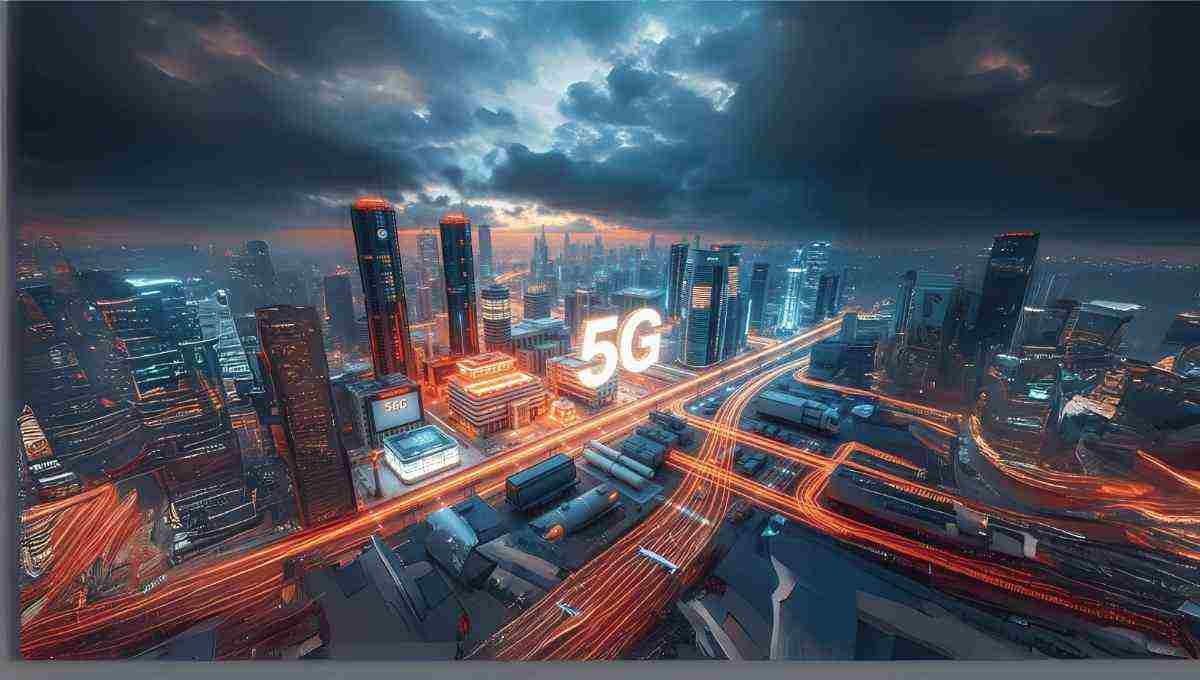MCCRM in 5G stands for Mission-Critical Communication Resource Management. It ensures reliable, secure, and real-time communication for systems where uninterrupted connectivity is essential, such as emergency services, healthcare, and industrial automation. By leveraging 5G’s ultra-reliable low-latency communication (URLLC) and advanced network features, MCCRM enables the smooth operation of critical applications, enhancing safety, efficiency, and performance across multiple industries.
MCCRM is the backbone of seamless communication, relying on real-time data to industries automating critical operations for emergency response teams. Mission-critical communication Resource Management (MCCRM) plays a pivotal role in ensuring reliable and secure connectivity for applications where failure is not an option. By leveraging 5G’s ultra-low latency and unparalleled speed, MCCRM supports advanced technologies like IoT, Mobile Edge Computing (MEC), and intelligent mobility. This article dives deep into the concept of MCCRM in 5G, its key features, and its transformative impact across industries like healthcare, defence, public safety, and infrastructure.
Table of Contents
Understanding What is MCCRM in 5G?
Mission-critical communication ensures uninterrupted connectivity for essential systems like emergency services, industrial automation, and public safety. 5G improves on 4G with lower latency, higher reliability, and the ability to handle complex operations seamlessly. These advancements make 5G indispensable for real-time applications where communication breakdowns can have severe consequences, offering a reliable backbone for mission-critical networks.
Evolution from Mission-Critical 4G to 5G
4G Networks:
4G offered robust communication with wide coverage and decent speed but struggled with ultra-low latency requirements and handling real-time applications. Industries needing immediate response times often faced performance bottlenecks. Although transformative at the time, 4G couldn’t fully support the growing demand for advanced mission-critical applications like autonomous vehicles and emergency services.
5G Networks:
5G surpasses 4G by introducing capabilities like enhanced mobile broadband (eMBB) and ultra-reliable low-latency communication (URLLC). These advancements enable 5G to support real-time applications, automate operations, and connect millions of IoT devices without interruptions. It’s a perfect fit for sectors requiring mission-critical communications, like healthcare and defence.
Key Features of Mission-Critical Networks
- Secure Connectivity: Security is paramount for mission-critical systems. 5G ensures robust data protection through advanced encryption, user authentication, and real-time threat detection. These features help maintain data integrity and privacy, making 5G networks ideal for critical public safety, defence, and healthcare applications where breaches can have catastrophic consequences.
- Resilient Network: Resilience in 5G networks is achieved through redundancy mechanisms and self-healing technologies. These ensure minimal downtime, even during hardware or software failures. This reliability is crucial for mission-critical applications, where connectivity interruptions could disrupt emergency services, industrial automation, or essential public infrastructure operations.
5G in Industry-Specific Mission-Critical Applications
5G offers tailored solutions across industries, enabling real-time communication, automation, and safety enhancements. 5G revolutionizes operations from defence to infrastructure by delivering ultra-reliable, high-speed networks. Industries relying on critical communication, such as public safety and energy grids, now have access to seamless, fail-safe systems designed to operate without interruptions.
Defence
In defence, 5G enables secure, real-time communication for command and control. This ensures military personnel can coordinate operations efficiently and respond to threats immediately. Its low-latency capabilities support advanced technologies like drone systems and battlefield AI, making defence strategies smarter, faster, and safer.
Public Safety
Public safety services like police, firefighters, and paramedics rely on 5G for uninterrupted communication. Real-time data sharing enables situational awareness during emergencies. This connectivity helps responders coordinate rescue efforts effectively and improve decision-making in critical moments, ultimately saving more lives.
Power Grid and Railway Systems
5G automates monitoring and control of power grids and railway systems, improving operational efficiency and safety. Smart grids detect faults and reroute power instantly, while railways benefit from automated signalling and real-time maintenance updates, reducing downtime and improving reliability.
Government Use
Governments leverage 5G to manage national infrastructure securely and efficiently. From disaster recovery operations to urban planning, 5G provides a robust communication backbone for public services. Secure networks also ensure sensitive data remains protected, supporting smooth governance and public safety efforts.
5G IoT and Intelligent Mobility: Transforming Connectivity
5G accelerates IoT adoption and intelligent mobility solutions, creating safer and more efficient cities. It enables interconnected systems that communicate seamlessly, improving transportation, reducing congestion, and fostering innovation. From autonomous cars to smart traffic management, 5G-powered IoT makes urban life smarter and more sustainable.
Vehicle-to-Everything (V2X): Smart Transport
V2X technology connects vehicles to infrastructure, pedestrians, and other vehicles. This communication reduces accidents, improves traffic flow, and enables automated transportation. With 5G, V2X delivers instant responses, making roads safer and optimizing the commuting experience for drivers and passengers.
In-Vehicle Entertainment
Passengers enjoy uninterrupted entertainment services with 5G’s high-speed connectivity. Whether it’s streaming movies, and music, or accessing real-time navigation systems, 5G ensures seamless, high-quality experiences. This enhances comfort and productivity during commutes, setting new standards for in-vehicle technology.
5G’s Impact on Video Surveillance and Healthcare
5G transforms video surveillance and healthcare by delivering high-speed, low-latency connections. Real-time monitoring ensures quick response times, while healthcare innovations like remote surgeries and telemedicine redefine patient care. These advancements rely on 5G’s ability to handle massive data streams effortlessly.
Video Surveillance
5G enables real-time video monitoring with AI-powered analytics. Security teams can quickly detect threats, monitor large areas, and respond instantly. Enhanced connectivity ensures smooth footage transmission even in high-traffic zones, improving safety in public and private spaces.
Medical Innovations
With 5G, healthcare professionals can perform remote consultations and even surgeries using high-definition video. Wearable health monitors collect and transmit patient data instantly, enabling proactive care. These innovations improve accessibility, especially in remote areas, transforming global healthcare delivery.
5G Mobile Edge Computing (MEC): Enhancing Mission-Critical Systems
5G MEC processes data closer to its source, improving latency and reliability for critical systems. By reducing dependence on central servers, MEC ensures faster responses and greater efficiency. It’s particularly beneficial for industries requiring real-time decisions.
Concept of MEC
MEC processes data at the edge of the network, reducing latency and improving communication reliability. This ensures mission-critical systems operate efficiently, whether it’s autonomous vehicles or industrial automation, by minimizing delays and enhancing responsiveness.
Advantages of MEC
Faster data processing supports critical decision-making in real time. By reducing the load on centralized servers, MEC improves system efficiency and ensures smooth operation. These features make MEC essential for industries requiring constant and reliable performance.
From Cloud to Edge
Shifting from cloud-based processing to edge computing reduces latency and improves resource utilization. This transition ensures mission-critical systems can handle high-demand operations without interruptions, supporting applications like telemedicine, autonomous vehicles, and smart grids.
Future-Proofing Mission-Critical Communications with 5G
As industries evolve, mission-critical systems must adapt. 5G’s advanced features ensure scalability, efficiency, and compatibility with emerging technologies. These efforts future-proof essential communication systems.
Standardization Efforts
Global 5G standards promote seamless interoperability between devices and networks. This ensures consistency and reliability, making 5G systems capable of supporting diverse industries with mission-critical needs.
Adapting to Emerging Challenges
5G integrates AI and IoT to tackle new challenges in mission-critical systems. From handling larger data volumes to enabling smarter automation, these technologies ensure 5G networks effectively address future demands.
Conclusion
MCCRM in 5G represents a significant leap in enabling reliable and secure communications for critical applications. From defence and public safety to healthcare and infrastructure, mission-critical systems depend on 5G’s unmatched speed, low latency, and robust performance. Integrating IoT, MEC, and URLLC, 5G supports real-time decision-making, smarter connectivity, and seamless operations across industries. As technology progresses, MCCRM in 5G continues to shape the future of secure, efficient, and resilient communication networks.
FAQ’s
What is MCCRM in 5G?
MCCRM in 5G stands for Mission-Critical Communication Resource Management. It ensures reliable, secure, and real-time communication for systems where uninterrupted connectivity is essential, such as emergency services, healthcare, and industrial automation.
How does 5G MEC improve mission-critical systems?
By processing data closer to the source, MEC reduces latency, ensuring faster and more reliable communication.
What industries benefit the most from MCCRM in 5G?
Defense, healthcare, public safety, and infrastructure management gain significant advantages from MCCRM systems.
Can 5G support real-time applications like remote surgeries
Yes, 5G’s low latency and high-speed data transfer enable applications like remote surgeries and telemedicine.
What is the role of URLLC in MCCRM?
URLLC ensures ultra-reliable and low-latency communication, essential for mission-critical tasks like emergency response.
How does MCCRM enhance public safety?
It enables seamless communication for first responders, improving coordination and efficiency during emergencies.
What is the CDM group in 5G?
The CDM group in 5G stands for Code Division Multiplexing. It refers to a method of channel access where multiple users share the same frequency spectrum, differentiated by unique codes. This enables efficient communication in mission-critical systems.
What are the 3 types of 5G?
The three types of 5G are Enhanced Mobile Broadband (eMBB), Ultra-Reliable Low-Latency Communication (URLLC), and Massive Machine-Type Communication (mMTC), supporting diverse applications like mission-critical systems.
What is MEC in 5G networks?
MEC, or Mobile Edge Computing, in 5G networks brings data processing closer to users. It reduces latency and enhances performance, making it essential for mission-critical applications. It complements what is MCCRM in 5G by improving real-time data handling.
What are mission-critical services in 5G?
Mission-critical services in 5G include ultra-reliable communication systems that support emergency services, healthcare, defence, and infrastructure. These services rely on low latency, high reliability, and secure connectivity to prevent failures.
What makes 5G essential for mission-critical networks?
5G provides ultra-low latency, high reliability, and scalability, making it indispensable for critical systems.

